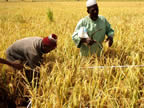Featured Items: APRIL 2012
April 22, 2012
EARTH DAY: Farmers Using the System of Rice Intensification are Doing Their Part
-
Combining Climate Change Mitigation with Adaptation Activities for Farmers at the Field Level
Earth Day, which falls on April 22 this year, is of course very relevant to SRI! Using less water, less agrochemicals, and less seed to get higher yields can help reduce the growing assault on the earth's resources and environment. The System of Rice
 Intensification also has a role to play in mitigating climate change by 1) reducing standing water (see photo at left), leading to decreased methane emissions; 2) reducing inorganic fertilizer use, leading to decreased carbon and nitrogen emissions from the manufacturing of fertilizers and their subsequent transportation over long distances; and 3) sustainable increases in the productivity of existing land, preventing the conversion of carbon sequestering forests to agricultural uses. (See methods section if you are uncertain what SRI methods entail).
Intensification also has a role to play in mitigating climate change by 1) reducing standing water (see photo at left), leading to decreased methane emissions; 2) reducing inorganic fertilizer use, leading to decreased carbon and nitrogen emissions from the manufacturing of fertilizers and their subsequent transportation over long distances; and 3) sustainable increases in the productivity of existing land, preventing the conversion of carbon sequestering forests to agricultural uses. (See methods section if you are uncertain what SRI methods entail).  However, while SRI does help to protect the environment, using SRI methods also helps farmers to adapt to climate change: Stronger roots help rice plants resist lodging in inclement weather, better withstand drought conditions, and, as indicated in recent reports from Sri Lanka, even help withstand flooding! (See photo at right of Harouna's large-rooted SRI rice plant in Timbuktu, Mali).
However, while SRI does help to protect the environment, using SRI methods also helps farmers to adapt to climate change: Stronger roots help rice plants resist lodging in inclement weather, better withstand drought conditions, and, as indicated in recent reports from Sri Lanka, even help withstand flooding! (See photo at right of Harouna's large-rooted SRI rice plant in Timbuktu, Mali). -
In Asia, where 40% of all fresh water is estimated to be diverted for rice irrigation, a single kilogram of rice requires an average of 2,500 liters of water (but can be as high as 5,000)! Since much less water is required with SRI, more farmers can share the available water; this is especially important as increasingly unpredictable weather patterns cause water shortages. In fact, state governments in Tamil Nadu, Bihar, and elsewhere in India are currently promoting SRI, partly due to water savings with SRI.
Of course, the benefits of SRI are not all related to climate change. Increased yields, another advantage of SRI, have been reported in 50 countries, and, health-related effects are being studied as well. In Kenya, Bancy Mati will soon release research results on how SRI water management breaks the mosquito breeding cycle and shows good prospects for malaria control. Another health impact is the reduction of arsenic levels in rice grown with SRI. This. however, is not surprising since arsenic generally enters the paddy in irrigation water and SRI recommends greatly reducing water use.
Is It Magic?
It sounds like magic, but it's really about working with plants and the environment in a climate-smart way that encourages nature to
 work for us! In short, SRI is based on reducing plant populations and water usage while improving soil conditions. SRI methods focus on providing optimal environmental conditions for individual plants rather than concentrating on managing dense plant populations. Planting single seedlings (instead of the usual 3+) with wider spacing (25cm x 25cm or more) reduces competition for nutrients; allows the canopy to open more fully to intercept more light for photosynthesis; and produces a less humid microclimate within the plant stand which is less favorable to pests and diseases. Planting younger seedlings (12 days old or less, instead of the usual 20+ days) encourages recovery from transplanting shock and leads to better root development. Using less water and improving soil with organic matter additionally promotes stronger, healthier roots, which in turn leads to increased tillering (when spacing is increased), more resistance to abiotic stresses and certain insects, a higher percentage of filled grains, and ultimately, a higher yield.
work for us! In short, SRI is based on reducing plant populations and water usage while improving soil conditions. SRI methods focus on providing optimal environmental conditions for individual plants rather than concentrating on managing dense plant populations. Planting single seedlings (instead of the usual 3+) with wider spacing (25cm x 25cm or more) reduces competition for nutrients; allows the canopy to open more fully to intercept more light for photosynthesis; and produces a less humid microclimate within the plant stand which is less favorable to pests and diseases. Planting younger seedlings (12 days old or less, instead of the usual 20+ days) encourages recovery from transplanting shock and leads to better root development. Using less water and improving soil with organic matter additionally promotes stronger, healthier roots, which in turn leads to increased tillering (when spacing is increased), more resistance to abiotic stresses and certain insects, a higher percentage of filled grains, and ultimately, a higher yield. Is There a Downside?
 SRI is not always easy to convince farmers to use and does not fit into all farming conditions. There is a learning curve involved, and, farmers frequently are somewhat resistant to changing longstanding traditions that have served them well in the past. Variations in established labor patterns can be problematic, the necessity for water control can be an issue, and there are more weeds to contend with. (Conoweeders and motorized weeders, which are becoming popular, have greatly reduced labor requirement associated with weeding though.... and these will be the subject of next month's feature.) Finally, despite a reduction in methane emission, a question not yet clarified is whether nitrous oxide is decreased or increased with various SRI adaptations. (Both methane, which is generated under flooded conditions, and nitrous oxide are important greenhouse gasses).
SRI is not always easy to convince farmers to use and does not fit into all farming conditions. There is a learning curve involved, and, farmers frequently are somewhat resistant to changing longstanding traditions that have served them well in the past. Variations in established labor patterns can be problematic, the necessity for water control can be an issue, and there are more weeds to contend with. (Conoweeders and motorized weeders, which are becoming popular, have greatly reduced labor requirement associated with weeding though.... and these will be the subject of next month's feature.) Finally, despite a reduction in methane emission, a question not yet clarified is whether nitrous oxide is decreased or increased with various SRI adaptations. (Both methane, which is generated under flooded conditions, and nitrous oxide are important greenhouse gasses).So, although SRI methods have been shown to increase yields in an environmentally sustainable way and to both mitigate climate change and help farmers to adapt to it, there are still some questions about where, how and why the System of Rice Intensification actually works. You can follow the story as it unfolds on our SRI website. We will keep you posted with the latest updates!
-
Is SRI for you?
You may want to look into it! You can try the "full SRI" or fit it to your own needs. (The System of Rice Intensification is "open source," so it is intended to be adapted to your own environmental, socioeconomic and cultural context.) Have a look at our videos page, instructional manuals page, methods page, FAQs, OR, if you want to try your own research, start with the SRI-Rice research articles page that is discussed directly below!
- HAPPY EARTH DAY !
- - The SRI-Rice Team
April 12, 2012
SRI RESEARCH: More Published Articles
about the System of Rice Intensification than You Might Think!
-

While critics sometimes point to a lack of research that can verify claims of SRI success, there may be more published research than most people are aware of. In addition to generating knowledge, SRI-Rice at Cornell University collects, organizes and shares information about the System of Rice Intensification (SRI) from all over the world. This week, we finished updating our collection of SRI research citations, and have been looking forward to sharing it with the global SRI community for quite a while!
250 Articles in Scientific Journals
The journal articles are listed in 1) a chronological list of 250 articles in scientific journals and 2) a searchable RefWorks database that (in most cases) includes abstracts. (While the chronological list contains only articles and communications published in journals, the RefWorks database can also pull up theses, conference presentations and some research posted directly on organizational and institutional websites.)
What about Access?!
Unfortunately, many of the journal articles listed are not free. Pay-per-view items may also be accessible through nearby libraries or research institutions, AGORA (for those who are in eligible countries), or by contacting the corresponding author. Even without access to the full articles, abstracts can be found by locating the title in the RefWorks database and clicking on the "view" button to the right of each title. (If there is interest, we could indicate on the list which items are freely available).
Still More Out There....
Our research database is far from complete! We recently finished a Chinese SRI research bibliography and in the coming weeks we hope to complete a preliminary India research bibliography. We know that there is far more research being carried out than we are capturing - especially in India, Indonesia and China. So, if you know of any publications (online or hard copy) that we are missing, please do send them our way: sririce@cornell.edu.
-
Here Are the Ways to Access SRI Research on the SRI-Rice website
-
Journal articles
 Chronological bibliographic listing
(journal articles from all countries)
Chronological bibliographic listing
(journal articles from all countries)- Searchable research database (RefWorks database that includes journal articles as well as theses and proceedings)
- Chinese research articles (chronological bibliography) and searchable Chinese RefWorks database
- Indian journal articles (forthcoming)
- Special SRI edition of Paddy and Water Environment (March 2011) - shown at right
- Research in specific countries (see articles or research/evaluation sections of specific country pages)
-
Theses
- The PhD dissertations and master's theses page contains research on SRI from universities in more than ten countries. Others that are not currently online will be made available soon!
-
Research presented at conferences and meetings
- Many articles, posters and presentations from conferences, forums, and other national and international meetings are included in the RefWorks research database. Some can be found on the conferences page. (We will soon be embarking on a proceedings page for India events, so please check the India page for updates.)
- The SRI-Rice slide presentations page provides access to 300+ (primarily) PowerPoint presentations, many of which contain research findings presented at conferences, forums and other meetings.
-
Research in other documents
- For research included in project reports, see reports and articles section of individual countries
- (For other non-research SRI publications and multimedia, see the general publications page)
(photo at top right of April 12 item by Erika Styger-- Hamidou Guindo and Mahamane Houssa collect yield data in the village of Hara Hara, Dire, Timbuktu, Mali)
---- The SRI-Rice Research Database Team: Lucy Fisher, Devon Jenkins, Erika Styger, Norman Uphoff, Weifen Qiu, Zhoucen Feng, Lorraine Perricone-Dazzo, Gene Fifer and Renling Zhang

